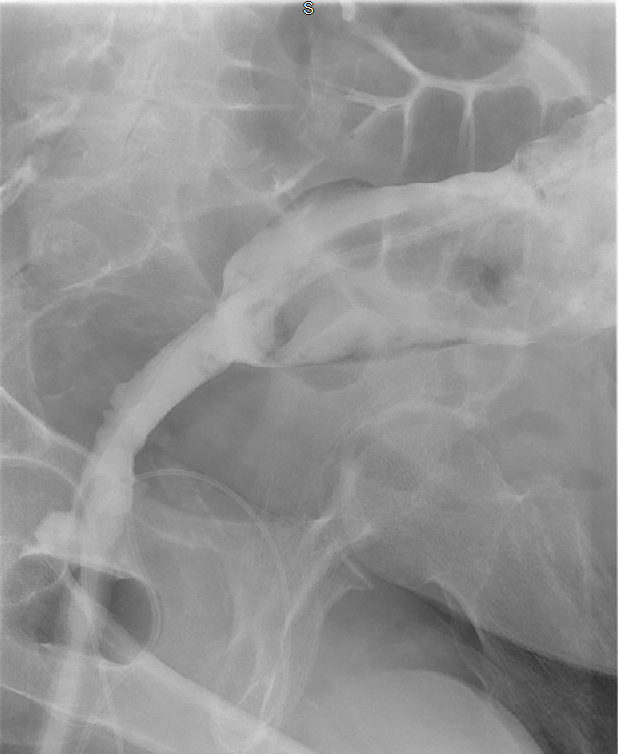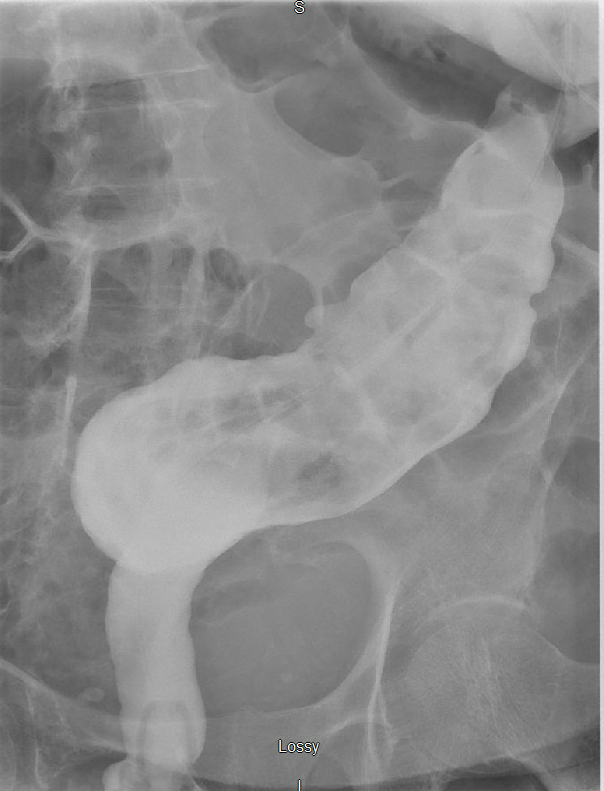Sunday Poster Session
Category: Colon
P0345 - Hirschsprung's Disease in a 91-Year-Old Male: Oldest Documented Case to Date
Sunday, October 26, 2025
3:30 PM - 7:00 PM PDT
Location: Exhibit Hall

Muhammad Arsalan, MD
St. Luke's Hospital
Chesterfield, MO
Presenting Author(s)
Muhammad Arsalan, MD1, Wagmah Javed. Khan, MD1, Jahangir Khan Afridi, MD2, Hameed Ullah, MD3, Anas M. Hasic, MD4, Sajid Zafar, MD5
1St. Luke's Hospital, Chesterfield, MO; 2St. Luke's Hospital Missouri, Chesterfield, MO; 3St Luke’s Hospital, Chesterfield, Chesterfield, MO; 4Sarajevo School of Science & Technology, Saint Louis, MO; 5St. Luke's Hospital, Saint Louis, MO
Introduction: Hirschsprung's disease (HD) is a congenital disorder defined by the absence of ganglion cells in the distal colon. Its prevalence varies from 1 to 1.63 per 10,000 births. Surgical treatment has reduced disease mortality to 3% in developed countries in younger populations, however mortality remains high in the elderly population. We present a rare case of a 91-year-old male with a long-standing history of diagnosed HD who was managed surgically leading to severe postoperative complications leading to his demise.
Case Description/
Methods: A 91-year-old man, with biopsy-proven Hirschsprung's at age 46, presented with two weeks of constipation and three days of obstipation. He managed his disease conservatively with magnesium, docusate sodium, and polyethylene glycol for many decades, requiring colonic decompression only once in his lifetime. On presentation, imaging revealed a completely collapsed rectum and a moderately dilated colon. Initially, colonic decompression was performed with rectal tube placement with no relief. Following this, he was treated with neostigmine however associated complications of sinus bradycardia and hypotension led to prompt ICU transfer.
After stabilization, an appropriate bowel regimen was initiated with minimal improvement. When conservative measures were exhausted, a surgical consult was made. The patient underwent a preoperational decompression sigmoidoscopy followed by a partial colectomy with colostomy. Soon after, he developed hypotension and acute hypoxic respiratory failure and ultimately passed away.
Discussion: With fewer than 300 adult cases reported over five decades, adult Hirschsprung's disease, defined as a diagnosis at the age of 10 years or older, is exceedingly rare. The average age at diagnosis is 24, with the oldest documented case reported being 74 years. It is usually managed conservatively with an appropriate bowel regimen; however, surgery remains the ultimate treatment for refractory cases. In elderly patients, less invasive techniques such as the modified Duhamel or Rehbein procedure may provide benefits, yet the risk of postoperative morbidity and mortality remains high. This case identifies the challenges of managing HD in the geriatric population and poses the question of whether surgery is the right decision to make in refractory cases or not. This case highlights the need for greater awareness and research needed to develop tailored management strategies for this population.

Figure: Image A: Coned frontal view contrast enema: Image shows reversal of rectosigmoid ratio with smooth narrowing of the rectum and relative proximal dilatation of the sigmoid colon, signifying the transition point.

Figure: Image B: Coned lateral view contrast enema: Image shows reversal of rectosigmoid ratio with smooth narrowing of the rectum and relative proximal dilatation of the sigmoid colon, signifying the transition point.
Disclosures:
Muhammad Arsalan indicated no relevant financial relationships.
Wagmah Khan indicated no relevant financial relationships.
Jahangir Khan Afridi indicated no relevant financial relationships.
Hameed Ullah indicated no relevant financial relationships.
Anas Hasic indicated no relevant financial relationships.
Sajid Zafar indicated no relevant financial relationships.
Muhammad Arsalan, MD1, Wagmah Javed. Khan, MD1, Jahangir Khan Afridi, MD2, Hameed Ullah, MD3, Anas M. Hasic, MD4, Sajid Zafar, MD5. P0345 - Hirschsprung's Disease in a 91-Year-Old Male: Oldest Documented Case to Date, ACG 2025 Annual Scientific Meeting Abstracts. Phoenix, AZ: American College of Gastroenterology.
1St. Luke's Hospital, Chesterfield, MO; 2St. Luke's Hospital Missouri, Chesterfield, MO; 3St Luke’s Hospital, Chesterfield, Chesterfield, MO; 4Sarajevo School of Science & Technology, Saint Louis, MO; 5St. Luke's Hospital, Saint Louis, MO
Introduction: Hirschsprung's disease (HD) is a congenital disorder defined by the absence of ganglion cells in the distal colon. Its prevalence varies from 1 to 1.63 per 10,000 births. Surgical treatment has reduced disease mortality to 3% in developed countries in younger populations, however mortality remains high in the elderly population. We present a rare case of a 91-year-old male with a long-standing history of diagnosed HD who was managed surgically leading to severe postoperative complications leading to his demise.
Case Description/
Methods: A 91-year-old man, with biopsy-proven Hirschsprung's at age 46, presented with two weeks of constipation and three days of obstipation. He managed his disease conservatively with magnesium, docusate sodium, and polyethylene glycol for many decades, requiring colonic decompression only once in his lifetime. On presentation, imaging revealed a completely collapsed rectum and a moderately dilated colon. Initially, colonic decompression was performed with rectal tube placement with no relief. Following this, he was treated with neostigmine however associated complications of sinus bradycardia and hypotension led to prompt ICU transfer.
After stabilization, an appropriate bowel regimen was initiated with minimal improvement. When conservative measures were exhausted, a surgical consult was made. The patient underwent a preoperational decompression sigmoidoscopy followed by a partial colectomy with colostomy. Soon after, he developed hypotension and acute hypoxic respiratory failure and ultimately passed away.
Discussion: With fewer than 300 adult cases reported over five decades, adult Hirschsprung's disease, defined as a diagnosis at the age of 10 years or older, is exceedingly rare. The average age at diagnosis is 24, with the oldest documented case reported being 74 years. It is usually managed conservatively with an appropriate bowel regimen; however, surgery remains the ultimate treatment for refractory cases. In elderly patients, less invasive techniques such as the modified Duhamel or Rehbein procedure may provide benefits, yet the risk of postoperative morbidity and mortality remains high. This case identifies the challenges of managing HD in the geriatric population and poses the question of whether surgery is the right decision to make in refractory cases or not. This case highlights the need for greater awareness and research needed to develop tailored management strategies for this population.

Figure: Image A: Coned frontal view contrast enema: Image shows reversal of rectosigmoid ratio with smooth narrowing of the rectum and relative proximal dilatation of the sigmoid colon, signifying the transition point.

Figure: Image B: Coned lateral view contrast enema: Image shows reversal of rectosigmoid ratio with smooth narrowing of the rectum and relative proximal dilatation of the sigmoid colon, signifying the transition point.
Disclosures:
Muhammad Arsalan indicated no relevant financial relationships.
Wagmah Khan indicated no relevant financial relationships.
Jahangir Khan Afridi indicated no relevant financial relationships.
Hameed Ullah indicated no relevant financial relationships.
Anas Hasic indicated no relevant financial relationships.
Sajid Zafar indicated no relevant financial relationships.
Muhammad Arsalan, MD1, Wagmah Javed. Khan, MD1, Jahangir Khan Afridi, MD2, Hameed Ullah, MD3, Anas M. Hasic, MD4, Sajid Zafar, MD5. P0345 - Hirschsprung's Disease in a 91-Year-Old Male: Oldest Documented Case to Date, ACG 2025 Annual Scientific Meeting Abstracts. Phoenix, AZ: American College of Gastroenterology.
